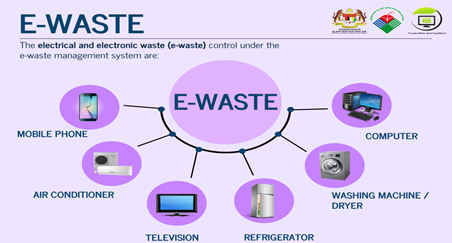

17th October 2022 (10 Topics)
Context
In a recently released 5th annual International E-Waste Day data, it has been found that hoarding small, unused, dead, or broken plug-in and battery-operated products creates One out of every six products of electronic items, ending to generate e-wastes in the average European household.
About
What is E-waste?
- E-Waste is short for Electronic-Waste and the term is used to describe old, end-of-life, or discarded electronic appliances. It includes their components, consumables, parts, and spares.
- It is categorized into 21 types under two broad categories:
- Information technology and communication equipment.
- Consumer electrical and electronics.
Key Highlights of the assessment:
- International E-Waste Day is held on October 14 every year as an opportunity to reflect on the impacts of e-waste.
- The theme for the year 2022 is ‘Recycle it all, no matter how small!’.
- Of 8,775 European households in six countries, the average household contains 74 e-products such as phones, tablets, laptops, electric tools, hair dryers, toasters, and other appliances (excluding lamps).
- The top five hoarded small electronic products were:
- Small electronics and accessories (e.g., headphones, remotes),
- small equipment (e.g., clocks, irons),
- small IT equipment (e.g., hard drives, routers, keyboards, and mice),
- mobile and smartphones,
- Small food preparation appliances (e.g., toasters, grills).

Global Scenario:
- Waste Electrical and Electronic Equipment (WEEE) Forum is an international association of 46 e-waste producer responsibility organizations.
- The forum released the results of surveys conducted to reveal why so many households and businesses fail to bring in for repair or recycling.
- The results were consolidated by the United Nations Institute for Training and Research (UNITAR) Sustainable Cycles Programme.
- Mobile phones/ smartphones have valuable gold, copper, silver, palladium, and other recyclable components.
India and E-Waste regulations:
- Laws to manage e-waste have been in place in India since 2011, mandating that only authorized dismantlers and recyclers collect e-waste. E-waste (Management) Rules, 2016 was enacted in 2017.
- India’s first e-waste clinic for segregating, processing, and disposal of waste from household and commercial units has been being set-up in Bhopal, Madhya Pradesh.
- According to the Central Pollution Control Board (CPCB), India generated more than 10 lakh tonnes of e-waste in 2019-20, an increase from 7 lakh tonnes in 2017-18. Against this, the e-waste dismantling capacity has not increased from 82 lakh tonnes since 2017-18.
- In 2018, the Ministry of Environment told the tribunal that 95% of e-waste in India is recycled by the informal sector and scrap dealers unscientifically dispose of it by burning or dissolving it in acids.
Government Initiatives for E-waste management:
Initiatives such as
- Extended Producer Responsibility;
- Design for Environment;
- (3Rs) Reduce, Reuse, Recycle technology platform for linking the market and facilitating the circular economy aim to encourage consumers to correctly dispose of e-waste.
Agencies responsible
- National Green Tribunal (NGT)
- Central Pollution Control Board (CPCB)
More Articles

